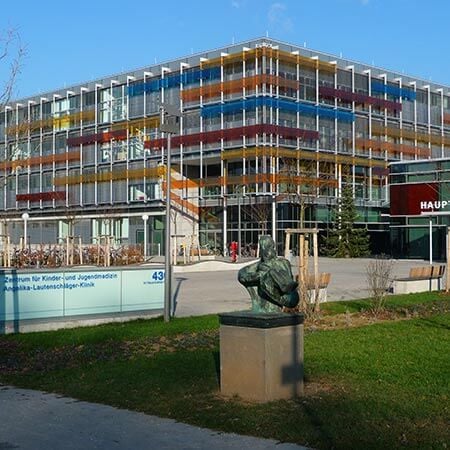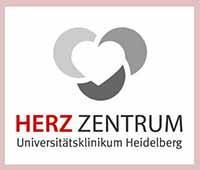Pulmonary stenosis is a congenital heart disease, usually isolated (without a combination with other heart defects). In most cases, the pathology is not dangerous and manifests itself with symptoms after reaching adulthood. Pathology is quite common: this disease accounts for about 10% of cases of heart defects. To treat the disease, doctors abroad mainly use minimally invasive procedures. Such procedures imply the dilatation of the valve area with a balloon, which is inserted through the blood vessels.
Content
- What is pulmonary stenosis
- What health problems can occur with pulmonary stenosis
- Diagnostics
- Treatment principles
- Minimally invasive valvuloplasty
- Balloon valvuloplasty in newborns
- Surgical treatment of pulmonary stenosis
- Minimally invasive pulmonary valve replacement surgery
- Why is it worth undergoing treatment abroad
- Treatment in Europe at an affordable price
What is pulmonary stenosis
Pulmonary stenosis is a narrowing of the opening through which blood flows from the heart into the pulmonary artery. In 90% of cases, the narrowing is localized at the level of the valve, while in 10% of cases stenosis is subvalvular or supravalvular. In about 20% of cases, the valve leaflets are underdeveloped (dysplasia).
There are three morphological types of heart defect:
- Funnel-shaped pulmonary valve. It is normally formed, but the leaflets are welded together, so they do not move well. The pulmonary artery trunk is often dilated. This variant of heart disease is the most common and most favorable. It usually responds well to minimally invasive treatment (cardiac catheterization with balloon valvuloplasty).
- Valve dysplasia. The stenosis develops due to the fact that the valves are minimally mobile and thickened. The narrowing of the pulmonary valve annulus and the right ventricular outflow tract is also possible. It is often one of the components of the genetic pathology, namely, Noonan syndrome.
- Monoleaflet or two-leaflet valve. This variant is often observed in tetralogy of Fallot, which is a severe congenital heart disease. The pulmonary valve of the heart has only one or two leaflets, although there should normally be three.
Heart defect is classified by the pressure gradient (drop) in the pulmonary artery. With mild pulmonary stenosis, the gradient does not exceed 30 mmHg, with moderate – it is up to 50 mmHg, and in case of severe form of the pathology, it is higher than this indicator.
What health problems can occur with pulmonary stenosis
Young children usually have no health problems. They develop normally and do not suffer from symptoms.
Nonetheless, as children grow older, the function of the right ventricle deteriorates. The average life expectancy for severe stenosis without treatment is 25 years. To avoid complications, even asymptomatic children require treatment of pulmonary valve stenosis.
Heart disease varies significantly from patient to patient. It can be severe when heart failure develops already in the second or third year of life, and it can be mild as well. Even without treatment, the patients suffering from the mild form of the pathology live up to 70-80 years.
Diagnostics
For the initial diagnostics of stenosis, doctors use the following methods:
- Echocardiography – the main method for detecting most heart defects.
- ECG – for the assessment of heart rate.
- Chest X-ray.
Echocardiography (ultrasound scanning of the heart) is a highly accurate and non-invasive examination. With its help, the doctor can see the valves and chambers of the heart, assess the function of the ventricles and approximately determine the pressure in the pulmonary artery. The specialist can also determine the severity of the stenosis. The results of the heart ultrasound are a basis for making a decision on the need for a surgical intervention. Based on these diagnostic results, the type of heart surgery is also chosen: it can be either an open surgery or a minimally invasive procedure for stenosis elimination.
There is no need for diagnostic cardiac catheterization. This procedure is performed only simultaneously with endovascular intervention to eliminate stenosis.
Treatment principles
Once a diagnosis is made, invasive treatment of stenosis is not always required. With a mild form, there are usually no symptoms, so patients are only observed. The ultrasound of the heart to clarify the severity of stenosis is performed once every 5 years. With moderate stenosis, patients are examined more often: once a year. When indications arise, patients are operated on.
Indications for minimally invasive elimination of pulmonary stenosis include:
- Peak gradient in the pulmonary artery exceeds 60 mmHg or the average one is more than 40 mmHg, without symptoms.
- Manifestation of symptoms, peak and average gradients of 50 and 30 mmHg, respectively.
Indications for surgery include:
- Combination of a defect with underdevelopment of the valve annulus, pulmonary regurgitation (valve insufficiency), supravalvular or subvalvular stenosis (narrowing).
- Any types of dysplasia (underdevelopment) of the pulmonary valve.
- Combination of pulmonary stenosis with tricuspid regurgitation.
If the stenosis requires treatment, then preference is given to a minimally invasive intervention, namely, balloon valvuloplasty. For the procedure to be successful, special equipment and experienced specialists are required.
In case of the surgical treatment of stenosis, preference is given to repair surgery. Less commonly, heart valve replacement is used. If valve replacement surgery is required, then biological prostheses are preferred in order to reduce the risk of blood clots. Dysfunction of the prosthesis may develop after 10-30 years. In this case, specialists in developed countries perform repeated replacement surgery using minimally invasive techniques: through the vessels on the leg.
Minimally invasive valvuloplasty
Transluminal balloon valvuloplasty is the standard treatment that is appropriate for most patients. This is a minimally invasive surgical intervention that is performed through an incision in the leg. The doctor inserts a catheter into the heart through the femoral artery.
The essence of the procedure is that a balloon is delivered to the area of the narrowed valve. It is inflated by injecting saline with a contrast agent inside. When expanding, the balloon enlarges the valve opening due to the separation of the commissures (connection of the leaflets).
The maximum efficiency of balloon valvuloplasty is achieved when surgical interventions are performed on the normal valve, without signs of dysplasia. The pulmonary valve annulus is very flexible and requires a balloon 40% larger than the diameter of the valve opening for adequate dilatation.
The procedure is safe for health and rarely causes complications. During the treatment of pulmonary valve stenosis, vagal (associated with the vagus nerve) symptoms, ventricular extrasystoles (extraordinary heartbeats) may occur. Pulmonary edema or perforation of the heart with the development of tamponade develops very rarely. To avoid complications, it is better to undergo treatment in a specialized and well-equipped cardiac surgery center, which regularly performs balloon valvuloplasty for children.
Due to balloon valvuloplasty, some patients may develop the following conditions:
- Heart block (bundle branch block, AV block).
- Pulmonary regurgitation (reverse blood flow to the pulmonary valve).
- Spasm of the right ventricle that can be eliminated with medicines.
Balloon valvuloplasty in newborns
The optimal age for minimally invasive interventions and operations is from 3 years. However, some babies have severe pulmonary stenosis and need treatment right after birth. In such situations, balloon valvuloplasty is successfully performed abroad. To provide treatment to newborns, TMP PED, Tyshak, Z-MED II, Sterling Over-The-Wire balloons are used.
In young children, the average diameter of the annulus fibrosus of the pulmonary valve is 9.2 mm. To dilate it, doctors use a balloon 20-40% larger, that is, from 12 to 14 mm.
Sometimes the annulus is too large or the femoral vein is narrow. In this case, medical specialists use a double balloon so as not to damage the vessels.
In newborns, the use of a double balloon can be problematic, as it increases the risk of damage to the tricuspid valve. It is located on the right side of the heart, between the atrium and the ventricle. With the double balloon technique, a double vascular access is required and the catheter is directed through the chordae tendineae and papillary muscles of the tricuspid valve. To minimize health risks, doctors use the single-balloon technique, but with the thinnest possible core. Doctors mainly use TMP PED, which requires a smaller conductor.
Thus, even the smallest children, including newborn infants, undergo safe treatment of pulmonary valve stenosis. In 85% of patients, the results of the intervention persist in the long-term period. In 15% of cases, repeated stenosis occurs. Typically, a relapse of the disease occurs in more severe forms of the defect with genetic syndromes and pulmonary valve dysplasia.
Surgical treatment of pulmonary stenosis
Open valvulotomy is an alternative to minimally invasive treatment. Historically, it is the first treatment method for pulmonary valve stenosis. Nonetheless, developed countries currently use open-heart surgery less and less frequently.
The first successful surgical valvulotomy was performed in 1948. Today, this method of treatment is used mainly in patients with pulmonary valve or pulmonary trunk dysplasia.
When stenosis is combined with insufficiency, valve replacement surgery becomes an option of choice. Doctors in developed countries almost do not use mechanical prostheses due to the high risk of complications, primarily the formation of blood clots and their entry into the pulmonary artery (pulmonary embolism). These are biological artificial valves that are predominantly implanted in this area.
The implantation of mechanical prostheses to replace any valves significantly increases the risk of thrombosis. Therefore, patients are forced to take anticoagulants for life. However, blood flow in the pulmonary artery is slow and the pressure is low. Therefore, blood clots are often formed here, despite taking anticoagulants.
Some patients require pulmonary trunk reduction. Sometimes prosthetic repair of the pulmonary trunk is required. Conduits (vascular prostheses), including valve-containing ones, are implanted in this area. They are made from donor vessels and pericardium, as well as materials of animal origin. In recent years, bioengineering conduits that can grow with the child have also been used.
Surgery for pulmonary valve stenosis is almost always successful. The mortality rate of patients is less than 1%. On average, the risk of the need for the repeated surgical intervention within 10 years is 30%, but in countries with advanced medicine this indicator does not exceed 10%.
Minimally invasive pulmonary valve replacement surgery
With combined pulmonary valve stenosis and insufficiency, patients undergo replacement surgery. Instead of the patient's own valve, an artificial, namely, biological one is implanted. It has a limited lifespan and degrades especially quickly in children.
Since the majority of patients who undergo surgical treatment are children or young people with a high life expectancy, sooner or later surgery for bioprosthesis dysfunction will be required. Surgeons abroad perform them using minimally invasive techniques: through the blood vessels instead of repeated open-heart surgery.
Transcatheter pulmonary valve implantation is performed through the femoral vein. The doctor conducts cardiac catheterization and implants a new bioprosthesis inside the old valve. Mostly Melody transcatheter valves are used. They are the best studied, as they have been implanted in more than 15 thousand patients, mainly from developed countries. In recent years, SAPIEN XT valves have also been used, providing comparable results with a lower risk of fracture of the prosthetic framework.
Transcatheter artificial valves are metal stents (frames) that contain leaflets made of animal materials. In the Melody valve, this is the jugular vein, and in the SAPIEN XT, it is the bovine pericardium. These valves serve for a long time. They are implanted through a minimally invasive access (femoral venous catheterization). The hospitals in developed countries achieve success in the implantation of the above artificial prostheses in 95-96% of cases.
Why is it worth undergoing treatment abroad
To undergo pulmonary stenosis treatment, you can travel to one of the countries with advanced medicine. There are several reasons for you to get medical care in Europe:
- Most interventions for pulmonary stenosis in children are performed using minimally invasive techniques: through the vessels in the leg (balloon valvuloplasty).
- Possibility of successful minimally invasive treatment even in the patients suffering from valve dysplasia (underdevelopment).
- Safe balloon valvuloplasty in children of any age, including newborn babies.
- Minimal risk of complications: damage to the tricuspid valve, development of pulmonary regurgitation and heart block.
- Those patients who have previously undergone pulmonary valve replacement surgery can have repeated bioprosthesis implanted with the use of minimally invasive techniques: through blood vessels instead of open-heart surgery.
- Success of transcatheter bioprosthesis implantation is achieved in more than 95% of patients.
- To perform valve replacement surgery, doctors use high-quality bioprostheses, which can last 15-30 years or more.
Heart disease treatment in Europe is safe for health, minimally traumatic, and provides good long-term results. Most patients will not need repeated surgery for pulmonary stenosis even after decades.
Treatment in Europe at an affordable price
To undergo treatment in one of the European hospitals, you can use the services of the specialists working in the Booking Health company. On our website, you can find out the cost of treatment in Europe, compare prices and book a medical care program at a favorable price. The treatment in Europe will be easier and faster for you, and the cost of treatment will be significantly lower.
You are welcome to leave your request on the Booking Health website. Our consultant will contact you within 24 hours. The medical tourism facilitator from the Booking Health company will take care of the organization of your trip for treatment in Europe. We will provide the following benefits for you:
- We will choose a hospital for treatment in Europe, whose doctors specialize in the treatment of pulmonary valve stenosis and achieve the best results.
- We will help you overcome the language barrier and establish communication with your attending physician.
- We will reduce the waiting time for the medical care program. You will receive medical services on the most suitable dates.
- We will reduce the price. The cost of treatment in European hospitals will be lower due to the lack of overpricing and additional coefficients for foreign patients.
- We will solve all organizational issues, such as paperwork, booking a hotel room, transfer from the airport to the hospital. An interpreter will accompany you abroad.
- We will prepare a program and translate medical documents. You will not have to repeat the previously performed diagnostic procedures.
- We will keep in touch with the hospital after the completion of treatment in Europe.
- We will organize additional medical examinations and treatment in a European hospital, if required.
- We will buy medicines abroad and forward them to your native country.
Your health will be in the good hands of the best specialists in the world. The Booking Health employees will help you reduce the cost of treatment, organize your trip, and you will be able to fully focus on restoring your health.
Authors:
This article was edited by medical experts, board-certified doctors Dr. Nadezhda Ivanisova, and Dr. Bohdan Mykhalniuk. For the treatment of the conditions referred to in the article, you must consult a doctor; the information in the article is not intended for self-medication!
Our editorial policy, which details our commitment to accuracy and transparency, is available here. Click this link to review our policies.




















